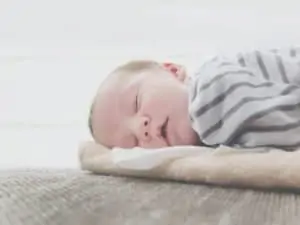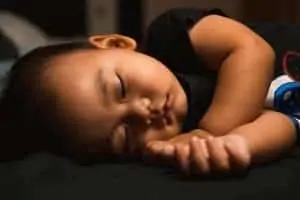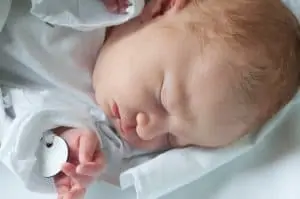You brought your baby home, and sleep is a distant memory. Everyone knows that babies and sleep don’t go hand in hand unless parents work toward creating an ideal sleeping environment for babies.
You might think babies should sleep whenever or wherever, but you’d be wrong. It can be complex to figure out the right temperature and lighting your baby enjoys. No matter what, several factors work together to create the perfect baby sleep environment.
My goal is to help you understand why the right temperature, lighting, and noise level can make your baby sound asleep. With these tips, you’ll finally get more sleep, even if it’s just an extra hour or two.
Get the Ideal Sleeping Temperature for Babies
Have you ever tried to sleep in a room that is too hot? I have, and I know that I didn’t get the most peaceful sleep. The same goes for when it’s too cold. Our heater broke, and I had to wait until the HVAC worker came in the morning to fix it. Our family was freezing all night!
The same goes for babies! 🙂
Most parents don’t realize that overheating is linked to Sudden Infant Death Syndrome (SIDS). So, if your baby is wrapped in a swaddle or a sleep sack along with a onesie or sleeper in a hot room, your baby can quickly overheat.
Note:
The ideal sleeping temperature for babies is between 68-72℉ (20-22°C), which is a comfortable range to keep in your home to ensure your baby is comfortable. Babies aren’t adaptable to temperature changes, so you do need to always keep an eye out for signs that your baby is either too cold or too hot.
Signs Your Baby is Too Cold
- Blue lips
- Cold chest area (nose and hands might be cool to the touch)
Signs Your Baby is Too Hot
- Fast heart rate
- Sweating
- Damp hair
Lighting Affects Your Baby’s Sleep Too
Do you sleep in a dark room? Chances are you do, and your baby also needs to sleep in a dark room. So, if you’re wondering, do babies sleep better in the dark, the answer is yes.
Sleep hormones are released in the dark, and it also helps regulate your newborn’s sleeping. When you first bring your baby home from the hospital, his days and nights might be messed up. To help get your baby onto the right cycle, keep the room as dark as possible at night and bright during daytime naps to get his sleep cycle on track.
So, when you prepare your baby’s room, you want to create cave-like darkness for your baby’s sleeping environment.

How do you get your baby’s room as dark as possible?
Try blackout curtains! These curtains are thicker than average and are designed to block light. A side benefit is that most of these curtains are thermal and help keep out the heat.
Another way to keep the room as dark as possible is to put butcher block paper over the windows and use blue painter’s tape to keep the paper in place.
The Right Noise Level for a Sleeping Baby
One of the biggest problems you might encounter is how much noise is appropriate for babies. Some babies wake up from any sudden sound, but others can sleep through a hurricane.
You want to ensure that you encourage good sleeping habits, and making the room completely silent is unrealistic. You want to be able to talk, watch a movie, or have friends over without disturbing your child.
One of the ways to do this is to add white noise to your baby’s room. A white noise machine creates loud sounds that are similar to the sounds your baby heard in your womb for nine months, so they’re comforting.
Believe it or not, the womb is not a silent place; it’s loud! Babies sleep better with constant sound because it sounds like where they spend their time.
To use white noise effectively, make sure it’s not too loud. It should never be louder than 50-60 dB. That’s similar to the noise level if you stood in a bathroom while someone was showering. Keep the white noise machine across from the crib rather than right beside it.
This is interesting:
Typically, it’s best to use a dull, constant sound, sort of like how the womb always had the whooshing sound of blood rushing and a heart beating.
Reduce Distractions
Nighttime is a time for peace in the home. It’s not the time for bright lights, roughhousing, or loudness. Babies need to be able to tell the difference between sleep time and playtime. So, try to reduce any stimulation before bedtime. Keep the TV off as well as any of your baby’s favorite songs.
That means you shouldn’t take your laptop or tablet to bed. Stay off your cell phone at night when you’re awake with your newborn. The lights from the phone not only cause a distraction but it prevents your body from producing as much melatonin as he needs.
Also, despite what you might have been told, babies don’t need mobiles or light machines in their rooms. They tend to be more of a distraction, adding to your baby’s requirements to fall asleep.
Don’t Forget Proper Sleep Habits
Once you have the right elements to create an excellent sleeping environment for your baby, you don’t want to forget all the essential, safe sleeping habits.
- Your baby should always be placed to sleep on his back. No matter what your grandmother might tell you about how she raised your parents, we know it’s safest for babies to sleep.
- Keeping your baby in your room is safest as well. Evidence shows us that room sharing for the first 6-12 months helps to reduce SIDS.
- Your baby should sleep alone on his or her sleeping surface. So, the crib can be a sidecar next to your bed or attach a co-sleeper to your bed, but your baby should be on a separate sleeping surface.
- Your baby’s crib must be empty. That means no loose blankets, even if you think your baby is cold. That’s why swaddling or using sleeping sacks is essential. A loose blanket can suffocate your child. Don’t use crib bumpers, comforters, or pillows because they increase the risk of SIDS or suffocation.
- Make sure your baby has a firm sleeping surface. Whether your baby has a crib or a bassinet, ensure it meets all standards set by the CPSC for safety.
Get Your Baby to Sleep
Sleep is one of the most challenging issues parents face in the first few months after their baby’s birth. Creating an ideal sleeping environment for your baby helps you get just a bit more sleep, which is what all parents need.
Hey, this is Linda. My biggest accomplishment in life is being a mother of four children. Their current ages range from almost ten years old down to 20 months old.
I’m passionate about writing parenting articles because I understand so well all of the problems and trials you face as a parent. From breastfeeding woes to budgeting problems and behavior problems, along with everything in between, chances are I’ve faced it over the last ten years. Read more about Linda here.






